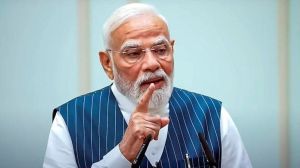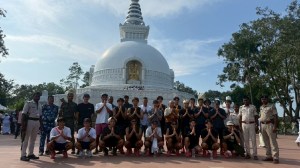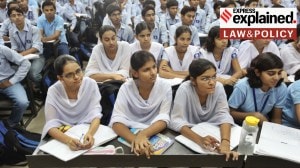Rashsundari Devi frequently refers to herself as a ”caged bird”. Her words critiquing her life in an affluent, upper caste family in Bengal were of great significance as it was for the first time that a woman in India was writing about herself. Amar Jiban (My life) published in 1876 was the first-ever full-scale autobiography written by an Indian woman.

Amar Jiban was an act of rebellion on many counts. Rashsundari was not only unlettered but was also forbidden from learning to read, to the extent that she would not even glance at a piece of paper for fear of being accused of knowing how to read.
Story continues below this ad
At the age of 25, however, she taught herself how to read the Vaishnav text, Chaitanya Bhagabat. She had sneaked the book out of the kitchen where her husband had left it for their eight-year-old son to read. She learned to read the text in secret, and in the next few years, she had read from a wide corpus of late medieval Bengali devotional or Bhakti texts. Over time, she drew from these works to reflect upon her own life.
A work of feminist literature
Rashsundari’s life in effect was that of any ordinary homemaker from an upper caste, landed family of Bengal. She was born in 1809 at a small village called Potajia. Having lost her father at a very early age, she was very close to her mother as is evident from her writings.
Like any girl of her time, Rashsundari was married off at the age of 12 to a landlord from Ramadia village in Faridpur named Sitanath Ray. Separated from her mother, she lived a life of what she describes as “bondage and imprisonment”. She started taking care of the entire household from the age of 14 and gave birth to 12 children in fairly rapid succession.
At the age of 59, Rashsundari was widowed and the following year, in 1897, she finished the first version of her autobiography. When she was 88, she added a second part to Amar Jiban and a new version of the book was published.
Story continues below this ad
Historian Tanika Sarkar in her detailed work on Amar Jiban titled, ‘Words to Win: The making of Amar Jiban’ (1999), notes that while “we do not have any records of the sales proceeds but it is significant that she was confident enough to go in for a second edition”. It carried a preface by the famed literary figure Jyotindranath Tagore, elder brother of Rabindranath Tagore.
Historians have over and again noted how the act of reading and writing was perhaps the only and most remarkable aspect of Rashsundari’s rather ordinary life. As Sarkar writes, she “possessed none of the criteria that presumably render a woman’s life noteworthy.” Yet in her strikingly individual attempt to access language by teaching herself to read, she had made a feminist revolution. Researcher Srija Sanyal in a paper on Amar Jiban written in 2021 that “perhaps no other autobiography dramatises the question of women’s access to language the way Amar Jiban does.” “The entire narrative that runs through the text echoes the daring step that a woman in the 19th century undertook towards penetrating the world of words, at a time when women’s literacy was not even a spared thought,” Sanyal writes.
Rashsundari’s accomplishment also lay in the fact that she was the first woman in India to reflect upon her own life. Her book serves as a means to understanding what women of the 19th century were perhaps thinking about the drudgery of their own everyday life, what their joys and desires, regrets and sorrows were. In that sense, Amar Jiban is a piece of feminist literature.
The first part of the book consists of 16 compositions, and the second part contains 15 compositions. Each composition is preceded by a dedicatory poem. “The tone, typical of Rassundari’s writing, is one of understatement and restraint, but what emerges is a clear indictment of the way Bengali society in her time treated women like her.” write authors Susie J Tharu and K Lalitha in their book, ‘Women writing in India: 600 BC to the early Twentieth century’ (1991).
Story continues below this ad
The context of time is also important here as this was the mid-19th century when Bengal was going through a period of intense reforms and women’s education had gained importance. But the first tentative efforts by Christian missionaries and Indian reformers to educate women had produced a sort of backlash from orthodox families who had further hardened their opinion on these matters. There was a firm belief that educated women were destined to be widows.
Rashsundari’s thoughts on such opinions come out clearly when she writes, “people used to despise women of learning. How unfortunate those women were, they said. They were no better than animals.” “In fact older women used to show a great deal of displeasure if they saw a piece of paper in the hands of a woman,” she writes as translated by writer Enakshi Chatterjee.
She also writes in detail about the pain and fear she experienced in being separated from her mother at such a tender age: “If I am asked to describe my state of mind, I would say that this was very much like the sacrificial goat being dragged to the altar, the same hopeless situation, the same agonised screams. I could see none of my relatives near me. I was miserable, and in tears I kept calling for my mother.”
The pain of separation from her mother is compounded by the misery of household work. The burden of the work was so much that she was prohibited from visiting her mother when she was at her deathbed, an incident about which she writes with great regret. “My grief knew no bounds. If I were a son I would have flown directly to my mother’s bedside. But I am helpless. I am a caged bird,” she writes.
Story continues below this ad
Rashsundari writes in emotive detail how she would often go without any meal in a day on account of having no time to spare from her work. Even when she narrates about the days she went hungry she is aware of the fact that women are conditioned to associate shame with the desire for food. “I should not dwell on those things, however. I feel ashamed even to mention them,” she writes.
In the sixth composition, Rashsundari writes about her desire to read and the travails she had to go through to make it come true. Once she had stolen her husband’s Chaitanya Bhagabat and hidden it in the khori (storage space in a Bengali kitchen) of her kitchen, she realised that she needed a teacher to guide her in reading or that she did not have the time for such an endeavor. She writes about how she kept praying to God to teach her how to read. Eventually she devised a way out. She kept the book in one hand and palm leaf on which one of her sons practised handwriting in the other. She had picked up some of the letters from having spent her early childhood years near a village school where the boys from her home went. On painstakingly comparing the letters in the book and her son’s palm leaf with what she knew from memory, she finally learned how to read.
She penned down her frustration in having to face such an ordeal for harbouring a desire to read: “Wasn’t it a matter to be regretted, that I had to go through all this humiliation just because I was a woman? Shut up like a thief, even trying to learn was considered an offense.”
Remarkably, in her account about her life, her husband barely finds a mention. She mentions about his death and pens down a formal obituary, simply because she believed people would want to know about him. As Sarkar writes, Rashsundari mourns the loss of her husband more as a social loss rather than a personal one. She mentions nothing about their personal life together, except that he was of considerable local importance. We are told that he knew nothing about her desire to read, nor about its fulfillment.
Story continues below this ad
A text inspired by Vaishnavite traditions
One has to read Rashsundari’s account of her life also in the context of the religious churning going on in Bengal in the 19th century and how that impacted the lives of women. Bengal in the late 19th century was experiencing a revival of ardent Vaishnavism. In her book, Rashsundar explains that it was her irrepressible urge to read a particular sacred text, the Chaitanya Bhagabat, that made her go through the struggle to read. This was the first Bengali biography of Chaitanya, the Vaishnava saint of medieval Bengal, well-known for his maddening love for Krishna.
Chaitanya’s Bhakti movement in Bengal promised salvation to the poor, the lower castes and to women or groups that were generally excluded by Brahmanical orthodoxy in higher spiritual learning. Consequently, the Vaishnav Bhakti movement of the 16th century in Bengal seemed to give a large amount of freedom to women. The great body of bhakti lyrics, for instance, gave voice to women’s emotions and desires. It also introduced reading habits of sacred vernacular texts among the subordinate groups like the lower castes and women. Sarkar in her article, ‘A book of her own. A life of her own. Autobiography of a 19th century woman’ (1993) writes that though the Vaishnava traditions appeared to liberate women, yet their liberation was restricted within a certain religious devotional sphere.
This makes perfect sense in the case of Rashsundari, who manages to express her desire to read and write only in the context of her urge to read a sacred Vaishnava text. In the course of time, she went on to read from a large spectrum of devotional or bhakti texts and books on the lives of Chaitanya and Krishna. In writing about her own life too, thereafter, she drew from these texts and repeatedly throughout the text emphasises upon her religious devotion even when complaining about the treatment meted out by virtue of being a woman. “Her life was meant to be read as if it was enclosed within a divine purpose, as almost an extension of God’s own life,” Sarkar writes. In fact the last sections of her autobiography describe not events from her own life, but rather from the various lives (incarnations) of Vishnu.
Throughout her writing, Rashsundari speaks of her life as a series of trials that she was able to overcome due to God’s grace. “How strange are the ways of God and the effects of his kindness! He heard my prayers and set out to grant me my wish,” she writes, about having stumbled upon the Chaitanya Bhagabat. “The little that I have learned was possible because God guided me,” she writes towards the end of her composition in which she describes her struggle to read. She adds, “God has looked after me well and I spent my time with a happy heart. Suffice it to say that whatever he does is for the best.”
































